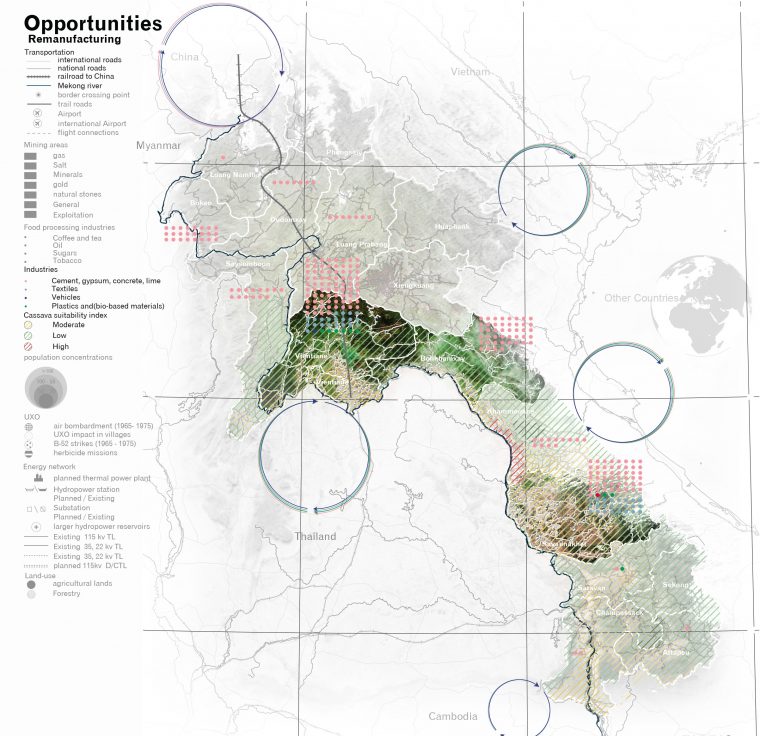Lao PDR is strategically located in the heart of Southeast Asia and a vital organ in the regional economic tissue. It supplies its own industries and consumers with food and resources, while also exporting large volumes of crucial supplies to surrounding countries. The country has an opportunity to leapfrog into a circular future, where economic activities and resource use are regenerative by design and safeguard the natural and cultural beauty which are unique to the country. Analysing the flows, conversions and stocks of materials and energy which constitute the metabolism of Lao PDR, bring the most promising circular economy strategies to the surface.
Development opportunities and challenges

Between 1990 and 2015 the domestic extraction of resources in Lao PDR increased from 10 to 71 million tons per year. Increased extraction and exports of wood, metal ores and refined copper were the main drivers of economic growth. This is a short-term growth strategy supresses the growth potential of non-extractive national industries.
The central location of Lao PDR in between the large economies of southeast Asia, and on existing and planned international transport arteries, is a major opportunity. Other competitive advantages are its access to hydropower resources, a solid agricultural and forestry basis for developing a bio-based economy and low wages. The critical development challenges for Lao PDR are the heavy reliance on:
- temporary resource rents to stimulate economic growth;
- raw material exports which prevents the growth of local industry; and
- the import of construction materials and fuels which can also be sourced locally.

Metabolic analysis to support low-carbon development
The analytical approach looks at Lao PDR as a system and combines resource efficiency with low-carbon development. These two development goals go well together, since 67 per cent of global greenhouse gas emissions are related to materials management. The opportunities build on circular economy strategies, which reduce the input of raw materials, improve the use of existing assets and reduce the output of harmful waste, including greenhouse gasses.
For developing countries, this approach represents a unique opportunity to redefine development and growth, through the lens of metabolic efficiency. For Lao PDR, it is an opportunity to skip the catching-up phase and leapfrog into a postindustrial society, where the living organism, rather than the machine from the industrial age, is the main source of inspiration.

Circular economy strategies
Three circular economy strategies have been selected for their positive impact on resource efficiency and greenhouse gas emissions, cross-sectoral impact and ability to inspire circular innovations across the Laotian economy. Artist impressions help conceptualise the strategies.
A resource hub on major regional transport arteries: The first is to use recycling and remanufacturing to close material cycles within Lao PDR and within the region. It positions Lao PDR as a resource hub on the newly build transit railroads and the Mekong river.
The import of end-of-life motorcycles and cores can replace the use of imported motorcycle parts produced from newly extracted raw materials. The manufacturing industry can also replace imported synthetic materials with nationally-available bio-based alternatives. Secondly, a new technology to sort fibres from waste textiles opens an opportunity to replace the import of new fibres for the textiles industry, with end-of-life textiles of national and regional origin. Where the stream of textiles residues is insufficient to meet national demand, organic fibres like hemp can close the gap. The textiles industry in Lao PDR could become one of the first to go circular, which creates an attractive marketing prospect. Finally, bioleaching is a technology where bacteria can make e-waste processing safer and cleaner.
Piloting circular construction methods in tourism: The second circular economy strategy is the use of cross laminated timber and bamboo to replace imported concrete and steel as the prime construction materials which support the construction boom in urban areas and the expansion of infrastructure. The use of national resources in the construction of new buildings can preserve a sense of national identity in the architecture of urban areas and resorts. This strategy is exemplified with a circular tourist resort. The tourism sector could be an early adopter of circular concepts, as an important part of a broader sustainability of eco-tourism ambition. The sector has a direct incentive to build and operate resorts while avoiding or minimizing its impact on natural surroundings, resources and even culture.
Algae farming to produce valuable bio-based materials and clean surface water: The third strategy is mobilizing the agricultural production capacity of hydropower reservoirs with the production of algae. The reservoirs represent a large, and still expanding, underused national asset. Algae production improves the quality of river water, while delivering valuable protein, fertilizer or raw material for fish oil or biofuels. These products can substitute imported meat and synthetic fertilizer, support fish breeding in Lao PRD or replace imported fossil fuels.

Download the full report here.
Client: UNDP
Partners: FABRIC, Circle Economy, Nathanaël Reuling
2016-17
____________________________________________________________________________________________________________
The report in pictures

Analysis of resource flows



Spatial analysis of promising circular economy strategies



Impressions of a circular future






